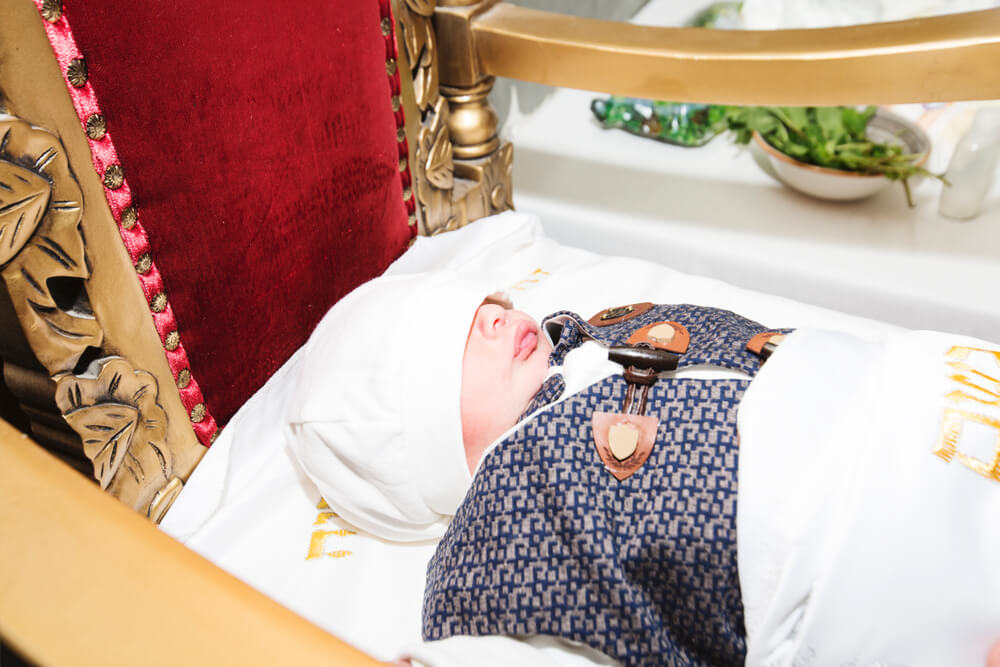The Brit Milah ceremony, a deeply significant ritual in Jewish tradition, marks the circumcision of a baby boy on his eighth day of life. While the focus is often on the procedure itself and the blessings recited, there’s a crucial role in this ceremony that plays a pivotal part in ensuring its success. That role belongs to the Sandek, an honorary position filled with symbolism and importance.
In this article, we will delve into the intriguing history and significance of the Sandek in the Brit Milah religious circumcision, shedding more light on the customs and practices that surround this honored position. After reading the article, you can always reach out to Dr. Krinsky and our expert team to learn more.
Understanding the Brit Milah Ceremony

Before we dive into the role of the Sandek, let’s take a moment to understand the Brit Milah ceremony itself. Brit Milah, often simply referred to as a “bris,” is a sacred Jewish ritual that dates back thousands of years. It involves the circumcision of a male infant on the eighth day of his life, signifying the covenant between God and the Jewish people. This ritual is considered one of the most important and meaningful traditions in Judaism, and it is a cause for celebration and joy within the Jewish community.
The Role of the Sandek
Now, let’s explore the central figure in the Brit Milah ceremony, the Sandek. The term “Sandek” is derived from the Greek word “syn-dekos,” which means “companion of the child.” The Sandek is an honorary position, and their primary role is to hold the baby during the circumcision.
The Significance of the Sandek
The Sandek’s role goes beyond merely holding the baby during the circumcision; it carries profound meaning and symbolism. Here are some key aspects of the Sandek’s significance:
- Protection: The Sandek is often seen as a protector of the child during this critical moment. They provide a sense of security and comfort to the baby, who may naturally be unsettled by the procedure.
- Spiritual Connection: By holding the baby during the circumcision, the Sandek forms a spiritual connection with the child, symbolizing their role in supporting the child’s journey into the covenant.
- Link to Tradition: The act of being the Sandek is a tradition in itself, often passed down through generations within a family. It connects the present to the past and emphasizes the continuity of Jewish heritage.
- Honorary Role: Being chosen as the Sandek is considered a significant honor within the Jewish community. It signifies the trust and respect that the family has for the individual who assumes this role.
Choosing the Sandek
The selection of the Sandek is a decision not taken lightly. Families often choose a relative or close friend who holds a special place in their hearts and embodies the values and principles they wish to impart to their child. It’s a role that requires not only physical presence but also a deep commitment to the child’s well-being and spiritual journey.
Selecting the Sandek is a choice rooted in deep sentiment and tradition. It is a decision that reflects the family’s desire to instill profound values and beliefs in their child. The individual chosen as the Sandek is often someone who not only has a close bond with the family but also exemplifies the qualities and virtues they hope their child will embrace as they grow. This special role entails not only being present during the ceremony but also serving as a spiritual guardian and protector, fostering the child’s connection to their faith and heritage. In essence, the Sandek becomes an embodiment of the family’s aspirations for their child’s journey within the Jewish community.
The Brit Milah Ceremony in Detail
The Brit Milah ceremony typically includes a series of blessings, prayers, and symbolic acts. Here is a brief overview of what you can expect during the ceremony:
- Welcoming the Child: The ceremony begins with the welcoming of the baby into the room where the Brit Milah will take place. The child is carried in by the Kvatterin (female counterpart to the Kvatter, who is responsible for bringing the baby to the circumcision).
- The Circumcision: The Sandek, in their honored position, holds the baby during the circumcision, which is performed by a qualified and experienced mohel (ritual circumciser). The mohel recites blessings during the procedure.
- Naming the Child: Following the circumcision, the child is officially named. This is a significant moment in the ceremony, as the child is given their Hebrew name, which will be used throughout their life for religious and ceremonial purposes.
- Celebration: The Brit Milah is a time for celebration, and a festive meal is often held afterward. Family and friends gather to share in the joy of the occasion.
The Sandek Bris: A Cherished Tradition
The “Sandek Bris” is a cherished part of the Brit Milah ceremony that further underscores the significance of the Sandek’s role. During this special moment, the baby is lovingly placed on Elijah’s Chair, a symbolic throne with a rich history. It is believed to have been employed by the prophet Elijah during circumcision ceremonies in the past, emphasizing the profound connection to the spiritual legacy of the Jewish people.
The Sandek Bris is a time of joy and tradition, where the family and community come together to celebrate. It often involves the singing of traditional songs that evoke a sense of unity and continuity. Blessings are recited, expressing gratitude for the Sandek’s pivotal role in ensuring the ceremony’s success and the child’s entrance into the covenant of the Jewish faith. This cherished moment reinforces the importance of faith, heritage, and community in the Jewish tradition, making it a treasured part of the Brit Milah ceremony.
Passing Down the Tradition

The role of the Sandek is not only significant in the context of a single ceremony but also in the broader context of passing down traditions and values from one generation to the next. Many families choose to honor their own cherished traditions by selecting the Sandek from within their close circle of relatives. This act reinforces the importance of family and heritage in the Jewish faith.
In Conclusion: The Enduring Significance of the Sandek
The Sandek, in their role as the guardian of the baby during the Brit Milah ceremony, holds a special place in the hearts of those who partake in this ancient tradition. Their actions go beyond the physical act of holding the child; they embody the spiritual connection between generations and play a crucial part in fostering the continuity of Jewish heritage. The Sandek is an honorary position that carries great meaning and symbolism, and its presence is a testament to the enduring significance of the Brit Milah ceremony in the Jewish faith.
That being said, if you would like to learn more about the ceremony or look for options regarding South Florida religious newborn circumcision services, feel free to schedule an appointment with Dr. Krinsky today.





